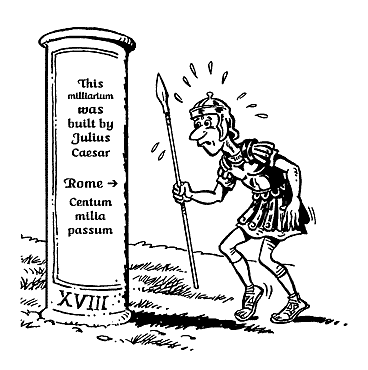Roads That Led to Rome, Part I, Section 2
(The Roads That Led to Rome by Victor W. Von Hagen)
The Monument, Section 2

The testimony of milestones and ancient Roman itineraries
There is vital information to be gleaned from the miliaria, the "milestones", which were erected every 1,000 paces, or Roman mile, on all Roman roads after 123 B.C.
- A massive cylindrical stone, over six feet in height and weighing two or more tons, the miliarium generally gave the distance from the town where the road originated, and name and titles of the emperor under whose auspices the road was build, sometimes the names of those who built it (". . . Legio III Augusta built this road") and sometimes the date when it was finished.
- In addition, the miliarium generally specified whether the road was repaired (restituit) or built at the emperor's own expense (pecunia sua) and whether it was a gravel road (via glarea) or a paved road (via strata).
- Such information, provided by miliaria and other Latin inscriptions, is incorporated in the collection of inscriptions, the Corpus Inscriptionum Latinarum.
- A miliarium found in situ is evidence that the road passed there, even when the road itself no longer exists.
- Thousands of miliaria have been removed; many are found to have been used in building houses, churches, and foundations, while others have been moved to museums and with no record made of their precise provenance (origin).
- Armed with ancient Roman itineraries, details from the classical writers, and voluminous studies of the Roman roads, one set out to find physical evidence of a given section of road.
- The problem is that two thousand years can change a landscape: rivers have risen, the road may have been buried under deep layers of detritus, and very often a city has retained its ancient name, but changed its locality; as happened in coastal Italy during the Middle Ages when marauding Moors caused the people to take to the hills.
- Under these circumstances, the directions of the original Roman roads may have been lost
- Throughout history men have made their way to markets,
- Early traffic was a luxury traffic.
- Men travelled a thousand miles, for example, to reach the Baltic Sea to obtain amber, a light and easily transportable item; cheap at the source, costly at the market.
